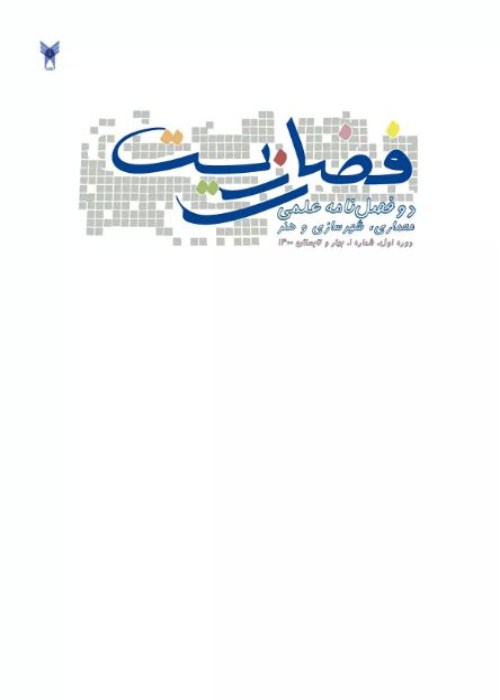The role of the age of the audience in understanding the concept of sense of place crystallized in the regional buildings of Khuzestan province
The research method is a combination of both qualitative and quantitative, which is conducted in the qualitative phase to extract the components of the sense of place in context-oriented structures, semi-structured interviews, and in the quantitative phase, a questionnaire with a Likert scale is designed and provided to spatial users. The results are collected in ORIGINPRO software and analyzed by PC. The results show that in the age group of 20 to 40 years, the highest factor contribution is related to activity, memorableness, social interactions and security with a value of (1.000) and the lowest factor contribution is related to The direction of the sun is (0.262), doors (0.265) and windows (0.274). In the age group of 40 to 60 years, the highest factor share is related to security, natural landscape, memorableness, giving meaning with a value of (1.000); And the lowest factor contribution is related to slope and unevenness (0.254), skyline (0.311) and doors (0.315). In the age group of 60 to 80 years, the highest factor contribution is related to green space, natural landscape, and social interactions. , comfort and security with a value of (1.000) and the lowest factor contribution is related to the indices of size (0.256), direction of the sun (0.266), uneven slope (0.244).With the expansion of communication methods in the modern world, social relations have declined and decreased. In the built buildings, the communication with the environment and its perception through various senses has been weakened and has created spaces lacking the necessary efficiency and performance (Mahmoudinejad et al., 2008: 284) Development in modern cities, man, city and It has made architecture unfamiliar with meaning and feeling and has created a large number of unknown and meaningless spaces, which has been much more in different age groups (Daneshpour et al., 2009: 39). So it can be said that these buildings are designed only for certain age groups. In general, losing the idea of the place of life can be one of the dominant crises in the present era and it has caused a change in the perception of memories in the residential complexes of the modern world and has turned them into a place without spirit and feeling. (Aegei, 2008: 45) The effect that architecture has on the human soul in the short and long term is undeniable, the space can be from a dry and soulless and cold body to a body in which the sense and spirit of the place flows, currently in Today's cities are empty of spaces that are full of a rich sense of place. (Nurberg Schultz, 2003: 48) Interest in the sense of place has grown rapidly in recent years, and the concept of spending time has expanded to entertainment and a wide range of programs (Madanipour). , 2000: 68) The concept of sense of place is an interdisciplinary concept that is studied in sciences such as psychology, sociology, architecture and geography. However, paying attention to place belonging has a historical background (Nurberg Schultz, 2014: 52). Paying attention to sustainable architecture and its principles is more and more on the agenda of different countries. One of these solutions is to develop the characteristics of the region, such as the body and environment, and to pay attention to the culture of each region. In short, the application of all these things can be called regionalism. Regionalism is a theory that advocates resistance to various forms of superiority, globalization, and standardized constructs that reduce ethnic differences. This theory suggests methods and criteria to protect the revival and, if necessary, rebuild the life of the framework of the region's characteristics (Bayzidi, 1392: 10). It emphasizes the cultural, geographical and climatic aspects of a particular region. In this research, while examining the issue of the sense of place, and extracting its components, the effect of each component in the age group of 20-40, 40-60, 60-80 is investigated. The scope of the study is buildings that have characteristics are regionalism, and the verification of a component happens in the qualitative part. In this research, the question is answered that in each age group, which of the components has a greater contribution in creating a sense of place in the regional buildings of Khuzestan province.
- حق عضویت دریافتی صرف حمایت از نشریات عضو و نگهداری، تکمیل و توسعه مگیران میشود.
- پرداخت حق اشتراک و دانلود مقالات اجازه بازنشر آن در سایر رسانههای چاپی و دیجیتال را به کاربر نمیدهد.


